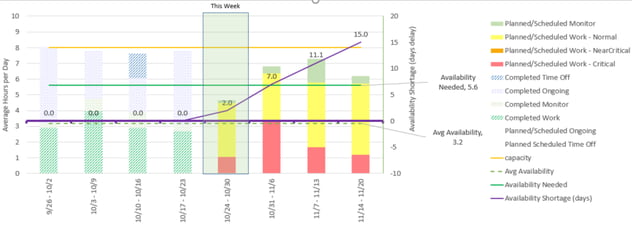The project team is falling behind schedule at a rapid rate. The major milestones and planned launch date are becoming further out of reach. You are struggling to understand why. On the surface, the team is running full speed ahead. Does this sound familiar? Understanding the team's true availability could be the answer to your project team woes...
Resource Availability
On most projects, team members are scheduled an average of 6 hours of tasks per day. However, what project teams are finding is that this level of loading is unrealistic. This is especially true when you take into account the additional non-project tasks that team members need to complete along with their project work.
Non-project tasks impact true availability
Non-project tasks include activities like production support, processing corrective and preventative actions, general team meetings and needed time away to refresh and reinvigorate, as well as other demands.
The fact of the matter is, we find the average number of hours a person has to work on project tasks is about 4 hours each day. Too often, the most important (critical chain) resources get even less – a lot less.
Here in lies the problem. Too much to do and not enough time.
Let’s peel this back a bit by looking at the following chart.

This chart shows a real engineer's workload -- let’s call her Jen -- across a period of eight weeks.
The 4 weeks on the left are actual time spent and show that Jen only gets about 3.2 hours a day for project tasks (dark green), after spending half of her time on non-project (purple) tasks and the occasional day off (blue).
The 4 weeks from this week forward show an expected utilization of 5.6 hours a day on project work tasks (yellow and red to show criticality). Doing the math, Jen is short 2.4 hours a day to complete project work.
Calculating Resource Availability
In "this week" alone we’ve booked Jen for 4.5 hours a day. According to our schedule, this should be a light week of work for Jen. In reality, by the end of the week, Jen will have about 5 * (4.5-3.2) = 6.5 hours of work that is behind schedule.
With only 3.2 hours a day, Jen is 2 days behind schedule after what was supposed to be a light week.
The story only gets worse from there.
Next week we have 6.4 hours of work per day planned for Jen. This is twice as much work as she has time to execute. By the end of week 2, Jen is an additional 5 days behind schedule.
(OMG!)
The following weeks are similar, and after only 4 short weeks Jen is 3 weeks (15 business days) behind schedule.
Underestimating how much work is involved
To compound the availability issue… It is also the case that we (humans) have a tendency to underestimate how much work is involved. If the work grows by a measly 20% from what was planned, Jen would be behind schedule by an additional 7 work days.
20 days * 5.6 hrs/day * 20% / 3.2 hrs
On the tasks in our plan, the work will generally grow by about 20%, but we must also include those tasks we didn’t think of when we were planning. Actual work growth in the 30-50% range is common, but even 20% has a large impact when resource availability is much lower than we expected.
Adding these factors together, it’s no wonder our best-laid project plans can quickly get off track.
Conclusion
As you can see, it’s critical to have a realistic understanding of how much time team members actually have to spend on project work. Usually, we overestimate availability and underestimate the level of effort involved in the completion of any given task. The inevitable results are project delays and high stress levels. But by understanding people’s real availability we can make changes to improve it, or at least have better expectations for when the project will finally be completed.
----
Ready to try Playbook? Learn the paradigm shifting concept around what truly causes project delays, then view the on demand webinar to see how Playbook helps project teams build more accurate project plans.
Related Posts
Daily stand up meetings - and free meeting agenda
Critical Chain project management
Resource loading and resource leveling



